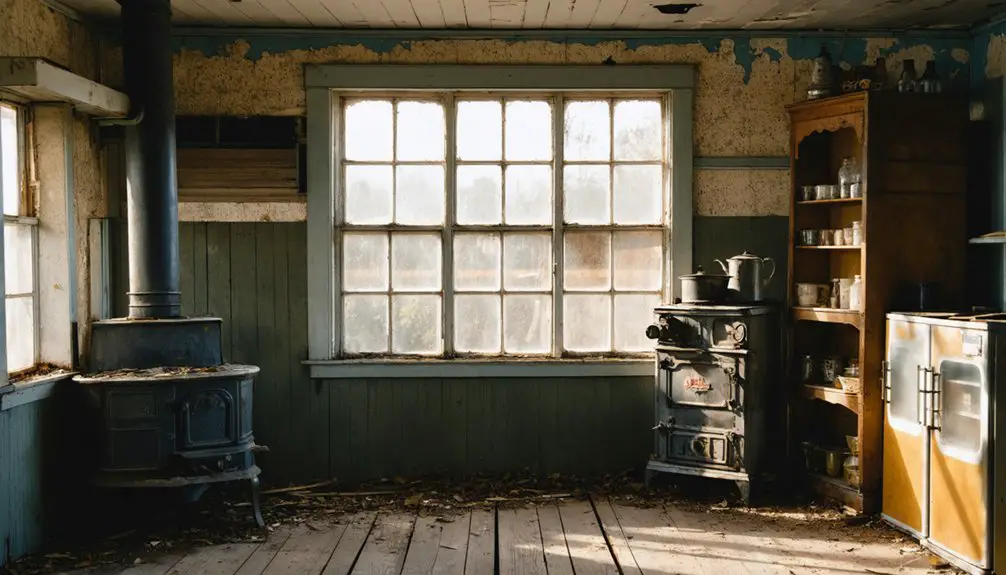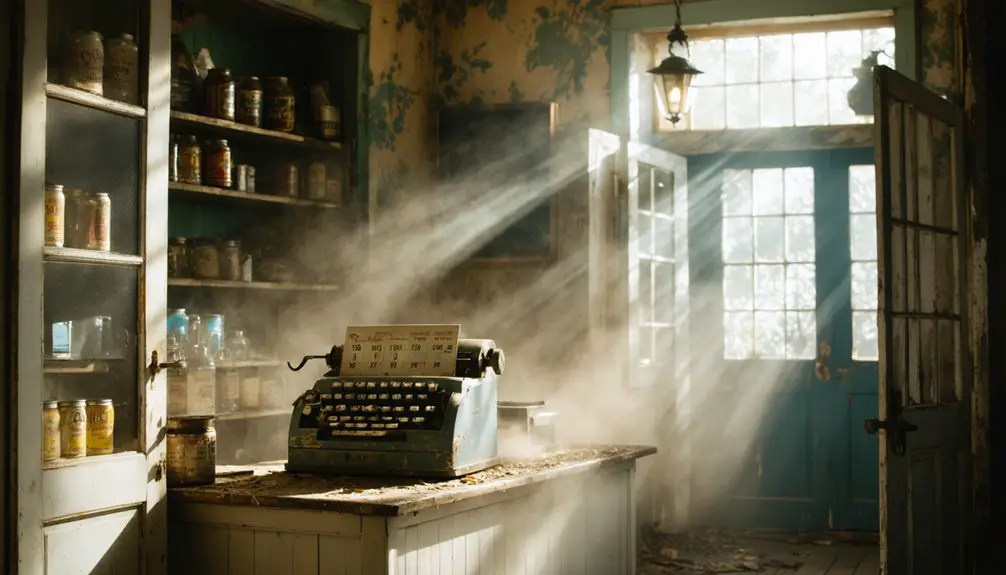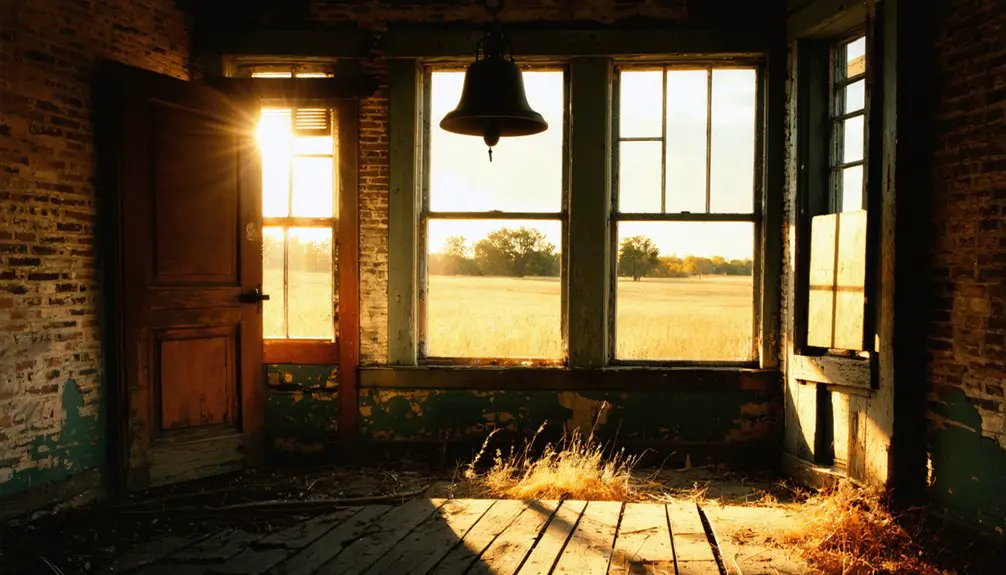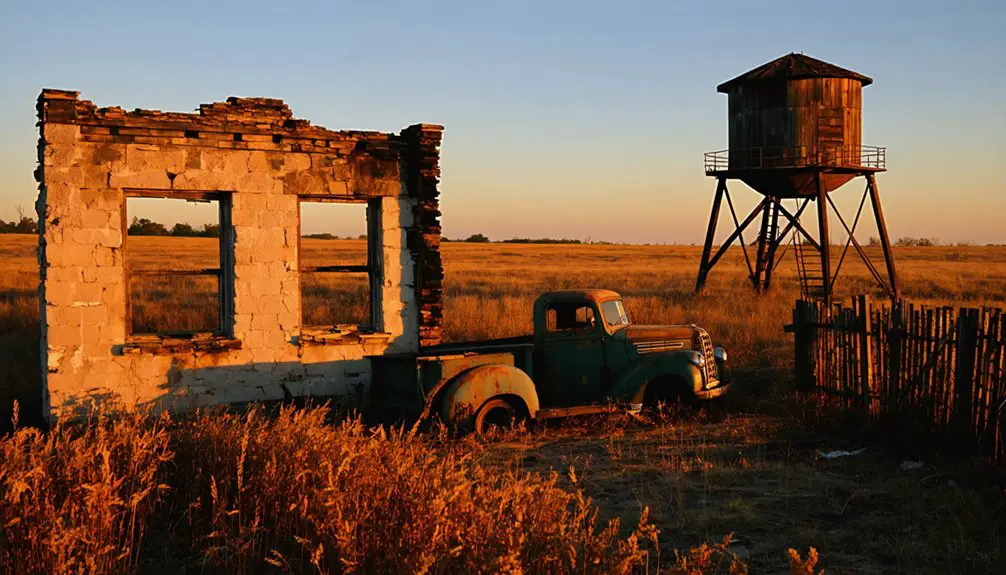You’ll find Beach Valley, Kansas among the forgotten settlements that emerged along the Santa Fe Trail around 1860. This frontier town thrived briefly through agriculture and local trade, featuring a trading post, hotel, and church as community anchors. Despite early promise, the town struggled with harsh weather, failing crops, and missed railroad connections. Today, only scattered ruins and foundations remain, telling a deeper story of prairie life’s triumphs and challenges.
Key Takeaways
- Beach Valley was established around 1860 during Kansas’s territorial expansion, starting as a frontier town along the Santa Fe Trail.
- The town’s decline began when it failed to secure crucial railroad connections, losing economic opportunities to neighboring communities.
- Agricultural challenges, including severe droughts and declining groundwater tables, contributed significantly to the town’s eventual abandonment.
- Most original structures have deteriorated over time, leaving only ruins that are now protected by local historical preservation efforts.
- Visitors must exercise caution when exploring the ghost town due to partially hidden ruins and lack of modern infrastructure.
The Rise and Fall of a Kansas Settlement
While the exact founding date of Beach Valley remains unclear, this Kansas settlement followed a pattern similar to many frontier towns that emerged during the state’s territorial expansion.
You’ll find its story mirrors the economic changes that shaped countless Plains communities, where early settlers established farms, businesses, and community services to build a thriving town.
Like many of its contemporaries, Beach Valley’s cultural significance grew alongside its development of essential infrastructure. Similar to Virginia City’s peak, the town supported various shops and services that served the local population.
You’d have seen a familiar scene: the establishment of local stores, churches, and schools that formed the backbone of frontier life. Much like Greenwood County’s overall trajectory, the town experienced a massive decline in population over time.
However, the town couldn’t escape the challenges that plagued rural Kansas communities, including agricultural hardships, shifting transportation routes, and the devastating impact of events like the Dust Bowl and Great Depression.
Life on the Prairie: Beach Valley’s Early Days
As settlers ventured into Beach Valley around 1860, they encountered vast stretches of open prairie where the Santa Fe Trail cut through what would become the town’s Main Street.
You’d find pioneers from Ohio and Kentucky establishing homesteads, hauling timber from distant forests to build their simple wooden homes on the treeless plains.
Daily life centered around Beach’s trading post, where you could exchange goods and catch up with fellow settlers.
The trading post served as both marketplace and meeting place, bringing settlers together to trade goods and share news.
The establishment of a post office brought essential communication links to the outside world.
While settler experiences varied, everyone faced similar prairie challenges – from limited building materials to adapting to grassland farming.
You’d witness the gradual transformation of former Kansa Indian lands as transportation routes expanded and new communities formed along the Santa Fe Trail.
Cow Creek served as a critical stopping point, with military troops stationed there to protect travelers from dangers further west.
The soil’s rich dark loam subsoil provided excellent conditions for wheat cultivation, helping sustain the growing settlement.
Agricultural Heritage and Farming Community
During the late 1800s, Beach Valley’s agricultural foundation took root through backbreaking labor and primitive farming methods. You’d find farmers using oxen teams to break just an acre of land per year, while hand-digging over 1,000 postholes to fence their 160-acre plots. As settlers often lacked experience, many were selected for politics rather than their farming capabilities.
The community’s farming techniques evolved from basic subsistence crops to a diverse agricultural system. You’ll recognize the wisdom in their approach – they didn’t put all their eggs in one basket.
Instead, they integrated corn-hog operations, later shifting toward wheat production when Turkey Red varieties arrived with Mennonite settlers. This community resilience showed in their adaptability, as families mastered multiple skills from crop cultivation to livestock management, creating a robust local economy that sustained Beach Valley through challenging times.
Weather Patterns and Natural Challenges
You’ll find that Beach Valley’s weather patterns mirror Kansas’s extreme climate shifts, with hot, muggy summers reaching 81°F and winters plunging to 31°F.
The region’s location in Tornado Alley exposes it to severe thunderstorms and powerful winds exceeding 12 mph, which historically threatened crops and buildings. Between October and May, the area experiences its windiest period with average speeds up to 12.4 mph.
The irregular precipitation patterns, ranging from intense rainfall to prolonged dry spells, created significant challenges for Beach Valley’s farming community and contributed to the area’s eventual decline. The area experiences four distinct seasons throughout the year, each bringing its own set of weather-related obstacles to local agriculture.
Seasonal Weather Extremes
While Kansas weather is known for its extremes, Beach Valley faced particularly challenging conditions due to its location and elevation.
You’ll find temperatures swinging dramatically from scorching 90°F summers to frigid winters where the mercury plunges into the teens. The town’s higher elevation made it remarkably colder than eastern Kansas areas, dropping 2-3°F per 1,000 feet. With today’s readings showing partly cloudy skies, these historical weather patterns continue to define the region.
These seasonal challenges tested residents’ weather resilience year-round. You’d experience intense rainfall in late spring, followed by summer storms bringing destructive hail and tornado risks.
Winter brought its own threats – brutal wind chills, treacherous snow-covered roads, and damaging freeze-thaw cycles that gradually destroyed buildings and infrastructure.
The harsh continental climate created a constant battle against nature, with rapid day-to-day temperature shifts making adaptation essential for survival.
Drought Impact Over Time
As prolonged droughts gripped Beach Valley throughout its inhabited years, the settlement’s viability steadily eroded through devastating cycles of water scarcity.
You’d find the town’s drought resilience tested repeatedly as declining groundwater tables restricted access to potable water for drinking and agriculture. The continental climate zone’s natural variability meant you couldn’t count on consistent rainfall, making crop planning nearly impossible.
Your daily life would’ve grown increasingly difficult as drought conditions strained household water usage and weakened local businesses. Much like Mindenmines, Missouri, the rainy season brought little relief to the parched landscape. Similar to Geuda Springs, the area once relied on natural springs that eventually dried up.
You’d have watched as soil fertility diminished, vegetation disappeared, and dust storms intensified. The water scarcity ultimately forced many of your neighbors to abandon their properties, leading to closed schools, shuttered stores, and a breakdown of community infrastructure that sealed Beach Valley’s fate.
Notable Buildings and Lost Architecture

You’ll find few remaining structural elements in Beach Valley today, with only scattered building foundations marking where this frontier community once stood.
The town’s most significant buildings included a modest one-room schoolhouse, post office, and several general stores that served as community gathering places.
While historical records and photographs document these simple wooden structures that characterized early Kansas settlements, none of the original buildings have survived the century of abandonment and decay.
Surviving Structural Remnants
The remnants of Beach Valley’s architectural past tell a haunting story of its once-thriving community.
You’ll find architectural features of notable significance in the surviving mining managers’ homes, where concrete bathtubs and built-in bookcases showcase the town’s former prosperity.
Throughout the abandoned structures, stenciled wallpaper and original fireplaces remain partially visible beneath layers of sand and debris.
Today, you can explore these remaining structural elements:
- Second-story rooms with precarious roofs and staircases that continue to deteriorate
- Railroad beds barely visible beneath encroaching sand and vegetation
- Commercial building foundations and damaged shells of former stores, mills, and blacksmith shops
While only two or three homes remain occupied in nearby ghost towns, most structures stand as silent witnesses to Beach Valley’s fading history.
Community Buildings Once Standing
During its prime, Beach Valley boasted a diverse collection of community buildings that served its bustling population.
You’d have found a prominent hotel that functioned as one of the town’s primary community hubs, complete with adjacent entertainment venues for dancing and gambling.
The local church, built in typical late 19th-century architectural styles with wooden construction, served multiple roles beyond spiritual guidance, hosting community meetings and educational activities.
The town’s school district, established around 1880, anchored the community’s commitment to education.
Commercial buildings lined the streets, including grocery stores, shoemakers, drugstores, and essential services like doctor’s offices and barbershops.
A post office marked Beach Valley’s official status, while professional services like attorney offices and banks reflected its brief economic prosperity.
Transportation and Trade Routes
Located near Lyons in Rice County, Kansas, Beach Valley‘s fate was intimately tied to the evolving transportation networks of the 19th century.
The region’s trade dynamics shifted dramatically as new routes emerged and older ones faded, shaping the community’s prospects for survival.
As transportation routes evolved, communities lived or died by their ability to adapt to changing trade patterns.
You’ll find that transportation evolution affected Beach Valley in three key ways:
- The establishment of Beach Trading Post in 1860 positioned the settlement to potentially benefit from regional commerce.
- The Missouri Pacific Railroad’s presence in nearby towns created competitive pressure for trade access.
- The community’s ultimate decline reflected its inability to secure crucial rail connections, while other locations gained strategic transport advantages.
These transportation patterns would prove decisive in Beach Valley’s transformation from a hopeful settlement to a ghost town of Kansas.
Daily Life in Beach Valley

Life in Beach Valley centered around a vibrant mix of residential, commercial, and social spaces that defined this once-thriving Kansas settlement. You’d find daily routines shaped by local businesses like grocery stores, blacksmith shops, and sawmills, while social gatherings took place at the church, school, and post office.
The town’s homes featured built-in fireplaces and bookcases, reflecting the residents’ modest prosperity. In your free time, you might’ve visited the saloons or tended to your manicured garden, though these green spaces have since surrendered to nature’s reclamation.
Life wasn’t always easy – you’d face seasonal challenges like droughts and grasshopper invasions that threatened crops and livelihoods. The community pulled together through local banks, manufacturing businesses, and religious institutions until economic hardships eventually led to the town’s decline.
Impact of Regional Development
Regional development dealt a devastating blow to Beach Valley’s survival through sweeping changes in transportation and commerce.
The town’s decline mirrored patterns seen across Kansas as economic shifts and regional infrastructure evolved, leaving smaller communities behind.
Small Kansas towns withered as modern infrastructure and shifting economies redirected prosperity toward bigger regional centers.
You’ll recognize these essential changes that sealed Beach Valley’s fate:
- Railroad modernization eliminated necessary stops, bypassing the town as diesel and electric trains reduced refueling needs.
- New highway systems diverted traffic away from the original town center, cutting off crucial commercial flows.
- Agricultural mechanization decreased local labor requirements while larger regional markets drew business activity to urban centers.
These transformations fundamentally altered Beach Valley’s economic landscape.
Like many rural Kansas communities, it couldn’t adapt to the changing dynamics of transportation networks and centralized commerce that now favored larger regional hubs.
Preserving Beach Valley’s Legacy

Despite the physical decline of Beach Valley, extensive preservation efforts have emerged to protect and document this historic Kansas ghost town‘s legacy. Through community initiatives, local historical societies maintain detailed records of the town’s remaining structures, cemeteries, and rail lines while collecting oral histories from descendants of former residents.
You’ll find preservation efforts focused on protecting key remnants through strategic fencing, stabilization of deteriorating structures, and installation of interpretive signage.
Historical photographs and archival materials help tell Beach Valley’s story, while organized tours and educational programs allow you to experience the site firsthand. Legal protections and grant funding support ongoing conservation work, ensuring that future generations can connect with this important piece of Kansas history through carefully maintained physical artifacts and documented accounts.
Exploring the Ghost Town Today
You’ll find Beach Valley’s deteriorating structures, including roofless buildings and sand-covered rail tracks, offer glimpses into its mining-era past through faded interiors and architectural details like cobalt-blue tiles and concrete bathtubs.
The town’s remnants are best viewed during early morning or late afternoon light when the sun reveals defining characteristics of the historical structures and former garden landscapes.
When exploring the site, you’ll need to exercise caution around unstable staircases and crumbling walls while watching for hazards created by natural erosion and sand accumulation.
Current Site Conditions
While Beach Valley’s ghost town site remains accessible via paved and partially maintained rural roads, today’s visitors will find a hauntingly quiet landscape where nature steadily reclaims the remnants of this abandoned settlement.
Native grasslands and prairie vegetation now dominate the terrain, with sporadic trees growing through old foundations and alongside deteriorating structures. Wildlife has made this peaceful setting their home, contributing to the site’s isolated atmosphere.
For the best exploration experience:
- Navigate carefully around partially hidden ruins and overgrown pathways
- Watch for wild animals and check for ticks during warmer months
- Visit during daylight hours when weather conditions are favorable
While some nearby properties remain occupied by residents who value rural solitude, most of Beach Valley’s original structures have succumbed to time and elements.
Remnants and Ruins
The remnants of Beach Valley offer a tangible window into Kansas frontier life through its scattered ruins and weathered artifacts. As you explore this ghost town, you’ll discover foundations of former homesteads in cleared fields, with scattered bricks and weathered beams marking where structures once stood.
Stone chimney bases serve as silent sentinels, while urban exploration reveals old cisterns and partially buried farm implements.
For historical archaeology enthusiasts, the site provides rich opportunities. You’ll find glass shards, ceramic pieces, and metal fragments that tell stories of daily life.
Ground depressions mark where wooden homes and businesses once thrived, while old well sites dot the landscape near former residences. Nature has steadily reclaimed the town, with prairie grasses and native trees growing among the ruins, creating an atmospheric reflection of frontier impermanence.
Safety When Visiting
Before starting your Beach Valley ghost town adventure, proper safety planning becomes essential for a secure exploration. As a visitor, you’ll need to maintain awareness of potential hazards while adhering to basic safety guidelines. Since the site lacks modern infrastructure and services, you’re responsible for your own well-being.
Key preparations for your visit:
- Drive a sturdy vehicle suitable for unpaved roads, and bring essential supplies including water, snacks, and navigation tools.
- Check weather conditions before departure, as severe weather can make access roads hazardous and exploration dangerous.
- Travel with companions when possible, carry a charged phone, and inform others of your planned route and return time.
Remember to respect private property boundaries and follow any posted regulations while exploring this historic site.
Frequently Asked Questions
Were Any Movies or Television Shows Ever Filmed in Beach Valley?
You won’t find any film locations or historical significance related to movies or TV shows in Beach Valley. No documented productions have ever used this ghost town for filming.
What Indigenous Tribes Lived in the Beach Valley Area Before Settlement?
You’ll find the Kanza (Kaw) people were the primary inhabitants of this area, with their tribal history centered along Kansas waterways. The Pawnee also had cultural significance in the broader region.
Did Beach Valley Have Its Own Newspaper or Local Publications?
Persistent probing of historical publications reveals you wouldn’t have found a dedicated local newspaper in this location. You’d have relied on larger regional papers for your local journalism needs.
Were There Any Reported Ghost Stories or Paranormal Activity?
You won’t find documented ghost sightings or paranormal encounters from Beach Valley. While Kansas ghost towns often inspire spooky tales, there’s no historical record of supernatural activity in this specific location.
What Happened to the Cemetery and Burial Records?
While you’d hope for better cemetery preservation, the burial documentation from Beach Valley’s cemetery has largely vanished. You’ll find most records were lost through decades of abandonment and neglect.
References
- https://stephentravels.com/top5/ghost-towns/
- https://www.youtube.com/watch?v=iB5rHT14eVI
- https://www.youtube.com/watch?v=KL2CXcc_HxY
- https://thewanderingpigeon.com/2015/10/03/day-of-kansas-ghost-towns/
- https://www.kcur.org/arts-life/2022-04-09/ghost-towns-are-all-around-kansas-city-if-you-know-where-to-look
- https://www.youtube.com/watch?v=alC1wDdSVvg
- https://fhsuguides.fhsu.edu/kansasheritage/ricecounty
- https://www.kancoll.org/books/cutler/mcpherson/mcpherson-co-p1.html
- https://en.wikipedia.org/wiki/History_of_Kansas
- https://www.rileycountyks.gov/441/History-of-Riley-County



